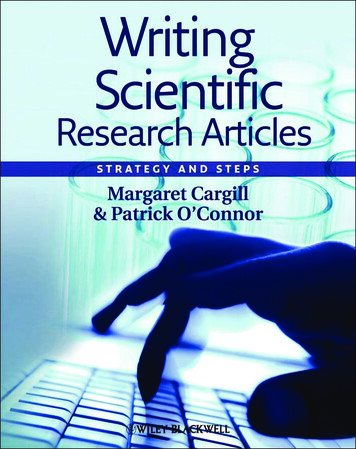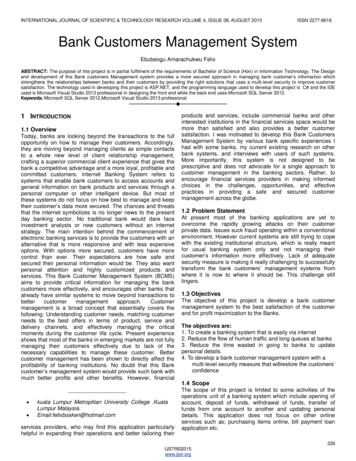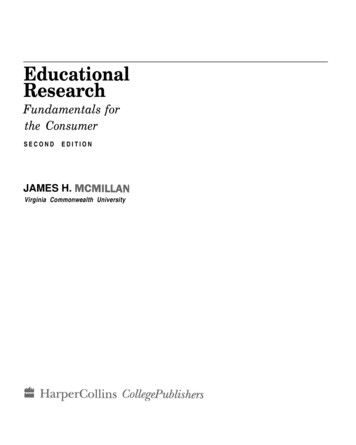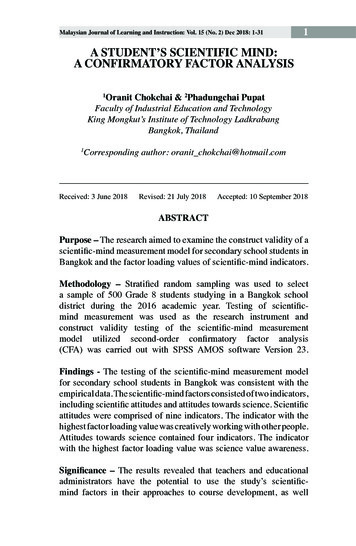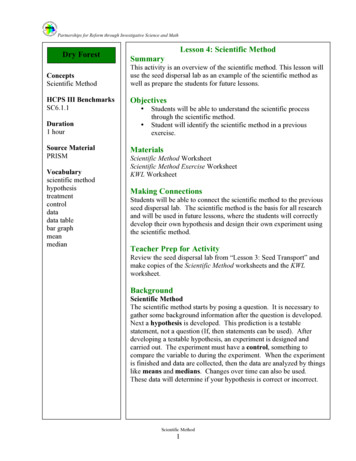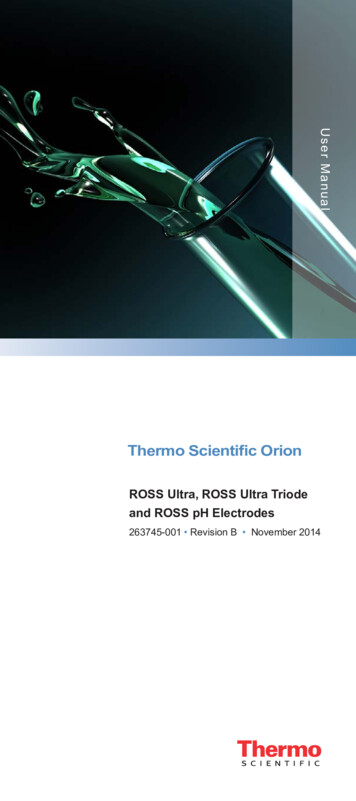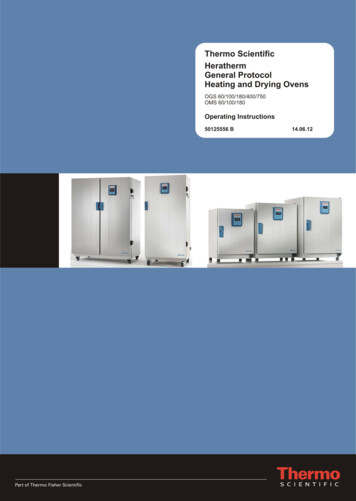
Transcription
INTERNATIONAL JOURNAL OF SCIENTIFIC & TECHNOLOGY RESEARCH VOLUME 9, ISSUE 04, APRIL 2020ISSN 2277-8616Risk Factors For Picky Eater In PreschoolChildren In An-Namiroh Kindergarten,Pekanbaru CityHastuti Marlina, Novita Rany, Linda Rosalina, Anni Faridah, Indah PermaisuriAbstract: A picky eater is a behavior of children who do not consume a variety of diverse foods so that it can cause the failure of growth anddevelopment, decreased intelligence, not focus on learning, cause infection, malnutrition, and even stunting in children. The purpose of the study was todetermine the risk factors for the occurrence of picky children in pre-school aged children in Pekanbaru's An Namiroh 4 Kindergarten in 2019. The typein this study is a type of quantitative analytic research with Cross-Sectional design. The location of this study will be conducted in Pekanbaru's AnNamiroh 4 Kindergarten in 2019. The population in this study were all kindergarten children at An Namiroh 4 Kindergarten Pekanbaru in 2019, whichwere 113 kindergarten children aged pre-school. Data collection using questionnaires, measuring TB and weight. The analysis used was univariate andbivariate analysis with a chi-square test with a confidence level of 95%. The results showed that the relationship between knowledge of mothers and theincidence of picky eater in pre-school age children obtained a value (P-value 0.014), the relationship between eating behavior of mothers with theincidence of picky eater in pre-school age children, obtained a value (P-value 0.032), the relationship between authoritarian parenting and picky eventsin pre-school age children, obtained a value (P-value 0.017, Exclusive Asi relationship with picky events in preschool-agee children, obtained a value(P-value 0.008) It is suggested to the teaching teacher in An Namiroh 4 Pekanbaru kindergarten to always see what food the child brings and giveadvice or input to the parents if the child is given food that is not diverse.Index Terms: Picky eater, Knowledge of maternal nutrition, mother's eating behavior, mother's parenting, and exclusive breastfeeding—————————— ——————————1 INTRODUCTIONPicky Eater is a behavior of children who do not consumediverse food variations, accompanied by rejection of certaintypes of food that are not liked, restrictions on certain types offood, especially vegetables and fruit, and are always notinterested in food in various ways done (Ramadan, 2017). Apicky eater is characterized by changes in behavior, lethargy,loss of appetite, and weight loss, this condition can certainlyinterfere with children's health. Unfortunately, many parentsare mistaken in getting around picky eater by giving milk as asolution, when in fact milk is only a complement (Rini, 2018)Research conducted in the United States by Shim (2011),which relates to picky eaters in preschoolers includes lack offood variation (58.1%), rejection of vegetables, fruit, meat, andfish (55.8%), and preference for methods certain cooking(51.2%). Research results in the Netherlands also showed thatthe prevalence of picky eater was highest at the age of 3 years(27.6%) when compared to 1.5 and 6 years of age (Chano,2015). Research in Canada also found that picky eaters havea risk that is 2 times greater for being underweight at age 4.5years than children who have never been picky eaters.Underweight will interfere with the development of intelligence,the learning process is more susceptible to infection,increasing the severity of the disease, to increase mortality(Dubois, 2007). Meanwhile, research by The GatesheadMillennium Baby Study in (2006) in the United Kingdom said,20% of parents said their children had eating problems, withthe highest prevalence of children wanting to eat only certainfoods.In Indonesia, the results of Imawati's study (2010) statedthat the prevalence of children under five who had difficultyeating was (23.9%), (45.5%) of which were picky eaterchildren (Imawati, 2010). Research Saraswati (2012), states stuti Marlina, Reproductive Health Department, STIKes HangTuah Pekanbaru, Riau, Indonesia, hastutimarlina56@gmail.com.081371887993that 82% of pre-school age children in Early ChildhoodEducation Kasih Ananda, Bekasi experienced picky eaterchildren, and research in Riau found that children whoexperienced picky eater were 35.4% (Kesuma, 2015) .According to the Ministry of Health (2012), there are around53% of children in under the age of 5 years suffer frommalnutrition caused by a lack of food to meet daily nutritionalneeds. The problem that will arise from this picky eaterbehavior is the low nutritional value of the food eaten, resultingin a child's nutritional status is low and included in the categoryof nutritional deficiency. Children with picky eaters can have alower Body Mass Index (BMI) value than children who are notpicky eaters. This can result in health problems such as aweak immune system and digestive problems (Dovey et al,2008 in Ramadan, 2017). If this problem continues the childwill experience growth or stunting failure, stunting children willbe shorter than normal children their age and have a delay inthinking (Rini, 2018). Based on the results of the 2017Nutrition Monitoring shows that the prevalence of stuntingtoddlers in Indonesia is still high, with a percentage of 29.6%above the limit set by WHO (20%) and stunting is also rankedfifth with children with severe malnutrition in the world. Rosie'sresearch results (2012), which states that the mother'sknowledge of nutrition has a significant effect on eatingdifficulties in children. By getting the results of the study of pvalue 0.003 0.05, it means that a meaningful relationship isobtained between the mother's knowledge of the difficulty ofeating in children.According to Anggraini's research (2014), mothers have animportant role in children's eating behavior. Some studies saythat the behavior of picky eaters in children is influenced byparents' eating behavior. Parents' eating habits are formedfrom the culture and norms prevailing in the society. Childrenwho grow up from families who are lazy to eat will encouragelazy eating behavior too (Sulistyoningsih, 2012). The results ofresearch conducted by Nafratilawati (2014) from the results ofstatistical tests found a significant relationship betweenparenting parents with difficulty eating in preschool children (35 years) in kindergarten Leyangan, Semarang Regency.170IJSTR 2020www.ijstr.org
INTERNATIONAL JOURNAL OF SCIENTIFIC & TECHNOLOGY RESEARCH VOLUME 9, ISSUE 04, APRIL 2020According to researchers that seen from the results ofresearch and analysis showed a significant relationshipbetween authoritarian parenting with difficult eating behaviorinpreschool children, this means that the mother's parenting isvery important for the formation of behavior and character ofthe child because children often imitate the habits andbehavior of parents both mother or father including imitatingthe eating habits of the mother or father. Research ResultsFinistrella et al. (2012) states, as many as 31.5% of childrenwho experience picky eaters and food neophobia have thenutritional status of being obese and can even be obesebecause of the picky eating behavior of children making foodconsumption uneven, especially fruit and vegetableconsumption. Lack of consumption of fruits and vegetables isthen replaced by consumption of processed foods, grains, andsnacks that are high in calories so that it is one of the triggersfor obesity and obesity and the results of research Antoniou etal. (2016) and Barse et al. (2015), states that picky eaterchildren tend to be malnourished and less likely to experienceobesity compared to children who are not picky eater. Theresults showed that exclusive breastfeeding for up to 6 monthscan reduce the likelihood of picky eater (AT, 2003), andchildren who are exclusively breastfed reduce the risk ofhaving picky eater behavior, desire to eat foods that arecooked in a certain way, and neophobia (Shim, Kim & Mathai,2011). Based on the results of an initial survey conducted bythe author in 3 (three) kindergartens namely Nurul ImanKindergarten, Nurul Islam and An Namiroh Kindergarten 4Pekanbaru. Of the 3 (three) kindergartens there is An Namiroh4 Kindergarten Pekanbaru, with the reason the author choseAn Namiroh 4 Kindergarten Pekanbaru because of theEducation Reference data in Tangkerang Selatan District BukitRaya Kindergarten An Namiroh 4 Pekanbaru has the mostpre-school age children in Pekanbaru City. At the time of theinitial survey, the results of the interview the authors get from10 parents whose children go to school in An NamirohKindergarten 4 Pekanbaru 8 pre-school children experiencepicky eater which is marked by picking out food, refusing if fed,closing mouth, difficult to eat, eat only a little, and only want toeat foods that are preferred, while 2 toddlers do notexperience picky eater. Based on the existing problems, theauthors are interested in researching "Risk Factors forOccurrence of Picky Eater in Pre-school age children in AnNamiroh 4 Pekanbaru Kindergarten".2 REVIEW OF LITERATURE2.1 Definition of a Picky EaterPicky eater according to Priyanah (2008), is the protection ofchildren who may not or refuse to eat, or overcome thedifficulty of eating food or drink with the appropriate type andamount physiologically (natural and reasonable), which isopened from now with no coercion, chewing, consumed, untilabsorbed indigestion without coercion and the provision ofcertain vitamins and drugs.ISSN 2277-8616kindergarten children in An Namiroh 4 PekanbaruKindergarten in 2019, namely as many as 113 kindergartenchildren who were preschool-aged (principal data of ANNamiroh 4 Pekanbaru Kindergarten). The sample in this studyall pre-school age children who are in An Namiroh 4Pekanbaru kindergarten with respondents mothers who havechildren in An Namiroh 4 Kindergarten Pekanbaru. The samplesize was 71 preschool-age children. The sampling techniquein this study is the Total Sampling technique, with the reasonthat the population is not so much. Samples taken from thisstudy are all pre-school age children in An Namiroh 4Kindergarten with respondents who have children in AnNamiroh 4 Kindergarten Pekanbaru in 2019 totaling 113 preschool age children, this has exceeded the minimum samplesize namely 71 pre-school age children. Data analysis usingthe Chi-square test.4 RESULT AND DISCUSSION4.1Relationship of Knowledge with Picky EaterTable 1Relationship of Knowledge with Picky EaterVariablePicky Eater R 3264957,535,643,417476442,5 4064,4 7356,6 113100100100Based on table 1 above shows from the number ofrespondents 40 people with less knowledge, known 23 people(57.5%) who experienced picky eater, while from the numberof respondents 73 people with good knowledge, known 26people (35.6%) experienced picky eater. Statistical test resultsusing Chi-square obtained P-value 0.041 ɑ0.05, then ha isaccepted and ho is rejected, it can be concluded that there is arelationship between knowledge andPicky eater. From theanalysis results obtained POR 2.446 1. This means thatrespondents with less risk knowledge 2.4 times experiencingPicky Eater compared to respondents with good knowledge.According to researchers, the relationship between maternalknowledge and the incidence of picky eater is seen from thedata of maternal characteristics in table 7, the majority ofeducation is in the high school level of 95 people (84.1%), sothe higher the level of mother's knowledge, the higher also forchildren not affected by picky eater. Suggestion, Even thoughmothers have no education, mothers should know the benefitsof what their children eat. Maybe you can learn throughtrending social media or from YouTube, you can learn fromthere.3 METHODThis type of research is quantitative analytic. Cross-Sectionalresearch design that explains the relationship of one variablewith other variables in the population studied to find therelationship of Risk Factors for the occurrence of Picky Eaterevents in Pre-School Age Children in Kindergarten AnNamiroh 4 Pekanbaru. The population in this study were all171IJSTR 2020www.ijstr.org
INTERNATIONAL JOURNAL OF SCIENTIFIC & TECHNOLOGY RESEARCH VOLUME 9, ISSUE 04, APRIL 20204.2 The Relationship Between Mother's Eating Behaviorand Picky EaterTable 2The Relationship Between Mother's Eating Behavior andPicky EaterVariablePicky Eater IncidentNotPickypickyTotalEaterEatern%n%n%Mother's eating behaviorFood1862,1ChooserNot a 456,6 113100P value0,032POR 95%CI2,798(1,1716,686)The table 2 shows that 29 respondents (62.1%) had pickyeater behavior from the mother's eating behavior. As for thenumber of respondents 84 people with eating behavior ofmothers who did not choose food, it is known that 31 people(36.9%) experienced picky eater. Statistical test results usingChi-square obtained P-value 0.032 ɑ0.05, that there is asignificant relationship between mother's eating behavior withPicky eater. From the analysis results obtained POR 2.798 1. This means that respondents with mothers who chose riskyfoods 2.7 times experienced picky eater compared torespondents with mothers who did not choose food. Thisresearch is in line with Carruth (2000), which concerns thatmothers who are picky about food influence their children'spicky eating behavior. A child may be less willing to try newfoods that his mother has never tasted. Children will receiveless foreign food if they observe the behavior of their parentsalso picky eating, maternal behavior will continue to influencethe child's picky eating behavior. According to researchers, therelationship between maternal eating behavior and picky eaterevents is seen from the data of maternal characteristics intable 7 of the majority of education at the high school level of95 people (84.1%) so the higher the level of knowledge of themother is obtained, the higher also for mothers to know thenumber of lack of nutritional intake if you choose food toMothers who choose when eating and do not want to eat avariety of foods, the child follows the mother's treatment.Suggestion, mothers should have good and healthy eatingbehavior that can be shown to children, for example whenmothers eat what their children dislike, mothers should try firstand tell their children so that children also eat.4.3 The Relationship Between Mother's Parenting andPicky EaterTable 3The Relationship Between Mother's Parenting and Picky EaterVariablePickyEatern%Picky Eater IncidentNot pickyTotalEatern%n%P valuePOR95% CI0,0172,942(1,2816,756)Mother's 41002835,45164,6791004943,46456,6113100ISSN 2277-8616Based on table 3 above shows from the number ofrespondents 34 people with authoritarian parenting, known to21 people (61.8%) who experienced Picky Eater. As for thenumber of respondents 79 people with democratic parenting,28 people (35.4%) experienced picky eater. Statistical testresults using Chi-square obtained P-value 0.017 ɑ0.05,then ha is accepted and ho is rejected, it can be concludedthat there is a relationship between parenting with Picky Eater.From the analysis results obtained POR 2,942 1. It meansthat respondents with parenting authoritarian mothers are atrisk 2.9 times experiencing Picky Eater compared torespondents with democratic parenting mothers. This study isin line with Najib (2016), with the title "Relationship betweenmother's parenting and eating difficult behavior in pre-schoolage children in kindergarten al-Ikhwah, Pontianak" states thatthe analysis of the relationship between maternal parentingand eating behavior of preschoolers in Kindergarten Al-IkhwahPontianak obtained a value of p 0,000 (p 0.05), whichmeans there is a relationship between parenting mothers withdifficult eating behavior of preschoolers in Kindergarten AlIkhwah Pontianak. According to researchers that seen fromthe results of research and analysis showed a meaningfulrelationship between authoritarian parenting with difficulteating behavior in preschoolers, this means that parenting isvery important for the formation of behavior and character ofchildren because children often mimic habits and the behaviorof parents, both mother, and father, includes imitating theeating habits of the mother or father. Therefore, parentinggreatly influences the growth and development of childrenespecially eating habits so that poor parenting can causechildren to experience difficulty eating behavior. Suggestions,mothers must have many ways and ideas for children so thatthe child wants to eat what he dislikes, for example, motherscan feed their children while playing and get to knowvegetables one by one while providing the benefits containedin the food.4.4 Exclusive Breastfeeding Relationship with PickyEaterTable 4Exclusive Breastfeeding Relationship with Picky EaterPicky Eater IncidentPickyNot pickyTotalVariableEaterEatern%n%n%Exclusive astfeedingTotal3057,72242,352P 611004943,46456,6113 100Based on table 4 above shows from the number ofrespondents 52 people with no exclusive breastfeeding,known to 30 people (57.7%) who experienced a picky eater.As for the number of respondents 61 people with exclusivebreastfeeding, it is known that 94 people (31.1%) experiencedpicky eater. Statistical test results using Chi-square obtainedP-value 0.008 ɑ0.05, there is a significant relationshipbetween exclusive breastfeeding with Picky eater. From theanalysis results obtained POR 3.014 with 95% CI 1.11-5.38),meaning that respondents who are not exclusively breastfed172IJSTR 2020www.ijstr.org
INTERNATIONAL JOURNAL OF SCIENTIFIC & TECHNOLOGY RESEARCH VOLUME 9, ISSUE 04, APRIL 2020risk 3 times experiencing Picky Eater compared torespondents with exclusive breastfeeding. This is in line withthe study of Shim, JE (2011), entitled "Children who areexclusively breastfed for 6 months have a lower chance ofdeveloping preferences for certain food preparation methodsby 78% (95% CI: 19% to 94% ), food rejection of 81% (95%CI: 31% to 94%), and food neophobia by 75% (95% CI: 11% to93%). Breastfeeding and the introduction of complementaryfoods after the age of 6 months reduces the likelihood ofdifficult eating in early childhood. This study documents therelationship between infant feeding practices and thedevelopment of voter eating behavior in early childhood.According to researchers, the majority of mothers do not giveexclusive breastfeeding to their children on the grounds,mothers cannot leave work, are busy, and have milksometimes it doesn't come out so it requires the mother to giveformula milk. Suggestion, however busy, the mother musthave time for the child to be fulfilled by the child, or maybe toobusy, the mother can store the milk in the refrigerator orbreastfeeding.5 CONCLUSIONBased on the results of interviews conducted by researchersat An Namiroh 4 Kindergarten Pekanbaru, it can be concludedthat:1. There is a relationship between exclusivebreastfeeding and the incidence of picky children2. There is a relationship between maternal parentingwith the incidence of picky eater children3. There is a relationship between maternal eatingbehavior and the incidence of picky eater children4. There is a relationship between maternal nutritionknowledge and the incidence of picky eater childrenREFERENCES[1] Anggraini, dkk, (2014). Hubungan bantuan ASI ekslusif dengankebijakan pemilih makanan pada anak usia 3-5 tahun diposyandu desa kemuning lor. Kecamatan Arjasa.[2] Anggraini, I. R. (2014). Perilaku Makan Orang Tuadengan Pemilih Pemilih Kejadian Pada Anak Usia Balita.Jurnal Keperawatan, 154-162.[3] Antoniu EE, Roefs A, Kremers SPJ, Jansen A, GubbelsJS, Sleddens EFC, dkk. (2016). Pilihan Makanan danPengembangan Status Berat Badan Anak: StudiLongitudinal. Hum Nur Diet, 29; (3); 298-307.[4] Aryani, A, AP. (2014). Aplikasi Metodologi PenelitianKesehatan dan Reproduksi. Yogyakarta: Nuha Medika.[5] Ayu, S.D., 2008. Pengaruh Program Pendamping GiziTerhadap Pola Asuh, Peristiwa Infeksi dan Status Gizibalita Kurang Energi Protein. Tesis, UniversitasDiponegoro.[6] Baumrin dalam Ubaedi (2009). Federasi Perawatan AnakKanada. Program pelatihan pengasuhan anak keluarga:nutrisi [Internet]; 2011. [Dikutip 2012, 20 Juli]; h/resources/onefournutrition.htm[7] Birch LL, Fisher JO, Grimm-Thomas K, Markey CN,Sawyer R, Johnson SL. Analisis faktor konfirmasi darikuesioner pemberian makan anak: ukuran sikap orangtua,ISSN 2277-8616[8] keyakinan dan praktik tentang pemberian makan anakdan kecenderungan obesitas. Appetite 2001; 36 (3); 20110.[9] Carruth BR, Ziegler PJ, Gordon A, Barr SI. PrevalensiPemakan Pilih-pilih antara Bayi dan Balita dan KeputusanPengasuh Mereka Tentang Menawarkan Makanan Baru.J Am Diet Assoc 2004; 104 (1): 57-64.[10] Carruth, (2000). "Meninjau kembali fenomena pemilihmakanan: perilaku neophobic anak-anak muda". Nov-Des;19 (6): 771-80.[11] Cerdasari, dkk (2017). Tekanan untuk makan dengankejadian pemilih makanan pada anak usia 2-3 tahun. Vol13 No 4: 170-178.[12] Chano SC, Tiemeir H, Hoeken D Van, Tharner A, JaddoeVWV, Hofman A, dkk. Tranjectories of picky eatingselama masa kanak-kanak: studi populasi umum. Int J EatDisord 2015; 48 (6): 570-9[13] Chao, H. dan Chang, H., 2016. Perilaku Memilih Makananyang Terkait dengan Interaksi Pengasuh-Anak yang ngan Umum pada Anak. Pediatri danNeonatologi. Claude, Anne dan Bernard Bonning, 2006.Menggabungkan masalah bayi dan balita. DokterKeluarga Kanada, Vol. 52, No. 6, hal. 1247-1251.[14] Damayanti, N. (2009). Hubungan peran dengan pemilihmakanan pada balita di posyandu RW 1 notoprajanwilayah kerja puskesmas ngampilan Yogyakarta. StikesAisyiyah Yogyakarta.[15] Daniel, & Jacob, A. (2012). Persepsi Pilihan Makanan diantara Anak-anak di Singapura dan DampaknyaTerhadap Pengasuh: Sebuah Survei Kuisioner. Asia PacFam Med. 11 (1), 1-8.[16] Dubois, dkk. (2007). Masalah Perilaku Makan TerkaitFaktor Sosial Dan Berat Badan Pada Anak Prasekolah:Studi Longitudinal. Jurnal Internasional Perilaku Gizi danAktivitas Fisik. Vol 4: 9[17] Eikstein dkk. (2010). Apakah Makanan PilihanPengukuran Berat-untuk-Panjang yang Sempurna padaAnak Kecil ?. Klinis Pediatrik. Vol. 4: 9[18] Finistrella V, Manco M, Ferrara A, Rustico C, Presaghi F,Morino G. Eksplorasi Lintas-Sectional dari LaporanMaternal tentang Makanan Neophobia dan Pilihan diPreschooler-Mother Dyads. J Am Coll Nutr 2012; 31 (3):152-9.[19] Gallow AT, Lee Y, Birch LL. Prediktor dan konsekuensidari neophobia makanan dan pilih-pilih pada anakperempuan, J Am Diet Assoc 2003; 103 (6): 698-2.[20] Haryansyah dan Aprilidayani (2017). Hubungan pola asuhorang tua terhadap kejadian pilih-pilih makanan (pilih-pilihmakanan) pada balita di bantul Yogyakarta. SkripsiFakultas Kedokteran dan Ilmu Keperawatan UMY.[21] Imawati. Kaitan antara pengasuhan dan kesulitan makandengan status gizi balita di Kelurahan Loktabat SelatanKotamadya Banjarbaru Provinsi Kalimantan Selatan.Skripsi. Yogyakarta: Universitas Gadjah Mada; 2010.[22] Judarwanto, W. (200). Kesulitan Makan dan AlergiMakanan Pada Anak. Jakarta: Klinik Pemilih.[23] Karaki, (2016). Hubungan pola asuh ibu dengan kesulitanmakan pada anak usia pra sekolah (3-5) tahun di tamankanak-kanak desa palelon kec.modinding minahasaselatan. e-journal Keperawatan (e-Kp) Volume 4 Nomor1Februari 2016. Fakultas kedokteran.173IJSTR 2020www.ijstr.org
INTERNATIONAL JOURNAL OF SCIENTIFIC & TECHNOLOGY RESEARCH VOLUME 9, ISSUE 04, APRIL 2020ISSN 2277-8616[24] Kemenkes RI. (2010). Status Antropometri PenilaianStatus Gizi Anak. Jakarta.[25] Kesuma, dkk (2015). Faktor-Faktor yang BerhubunganDengan Perilaku Kesulitan Makan Pada Anak PraSekolah. [Skripsi] Riau: Universitas Riau; 2015[26] Kwon, dkk (2017). Hubungan antara Perilaku Pilih-pilihMakanan dan Status Gizi pada Anak Usia Dini: KinerjaKuisioner Perilaku Memilih-pilih Makanan. Nutrisi Jurnal.Perpustakaan Nasional Kedokteran Amerika Serikat.Institut Kesehatan Nasional.[27] Lestari, P. 2013. Hubungan Pola Asuh Ibu Tentangmakanan dengan Status Gizi Anak Prasekolah dikelurahan Semanggi dan Sangkrah kecamatan PasarKliwon Surakarta. Naskah Publikasi, UniversitasMuhammadiyah Surakarta.Li, et all., 2017. Persepsitentang Asupan Makanan dan Status Berat BadanDiantara Orang Tua yang Memilih Bayi PengambilanMakanan dan Balita di Tiongkok: Sebuah StudiCrosssectional. Appetite 108 (456-463).[28] Mahfoedz dan Suryani, (2007). Hubungan lamapendidikan dan pengetahuan ibu tentang gizi seimbangdengan pemberian bantuan makan di Puskesmasgilingan.Surakarta. Skripsi[29] Najib, A, dkk. (2016). Hubungan pola asuh ibu dengankesulitan makan pada anak usia pra sekolah di awatanFakultasKedokteranUniversitasTanjungpura, Sekolah Tinggi Ilmu KeperawatanMuhammadiyah Pontianak, Program Studi KedokteranKeperawatan Universitas Tanjungpura).[30] Noorlaila, Iva. (2010). Panduan Lengkap Mengajar Paud.Yogyakarta: Penerbit Buku Pinus.[31] Notoadmojo, S. (2010). Metodologi Penelitian Kesehatan.Jakarta: Rineka Cipta[32] Nurjanah. (2013). Faktor-faktor yang Berhubungandengan Terjadinya Pemilih Pemilih Pada Anak Balita diTK negeri Pembina Kecamatan Simpang Tiga.[33] Patmonodewo, S. (2008). Pendidikan Anak Prasekolah.Jakarta: Rineka Cipta.[34] Powel, EA. (2011). Penghindaran makanan pada anakanak mempengaruhi praktik dan perilaku pemberianmakan ibu.[35] Priyanah. (2008). Gambran Karakteristik Anak PemilihPemilih yang Pernah Memeriksakan Diri di Klinik PemetikPemilih Jakarta Tahun 2008. [Skripsi]. FKM UI, Depok[36] Priyanti, S. (2013). Pilihan Perilaku Orang Tua TerhadapPemilih Pemilih Kejadian (pilih-pilih makanan) pada anakTodller di desa karang jeruk kecamatan jatirejo mojokerto.Vol 5. No. 2 (2013). Politeknik Kesehatan MajapahitMojokerto.[37] Rahman (2016), Hubungan Pola Asuh Ibu denganPerilaku Sulit Makan Pada Anak Usia Prasekolah diTaman Kanak-Kanak Al-Ikhwah Pontianak. Skripsi.Fakultas Kedokteran Universitas Tanjung Pura Pontianak.[38] Rahmawati, S., & Utari, D. M., 2013. Faktor PredominanPerilaku Pilih-pilih Euring pada Siswa KB / TK Islam AlAzhar 1 Jakarta Tahun 2013.[39] Ramadhanu, A (2017). Hubungan antara anak pemilihmakanan dengan nilai status gizi pada anak usia 4-6tahun di TK PWP I PLAJU Palembang Sumatera Selatan.Skripsi. Fakultas Kedokteran UMP.174IJSTR 2020www.ijstr.org
the prevalence of picky eater was highest at the age of 3 years (27.6%) when compared to 1.5 and 6 years of age (Chano, 2015). Research in Canada also found that picky eaters have a risk that is 2 times greater for being underweight at age 4.5 years than children who have never been picky eaters.




